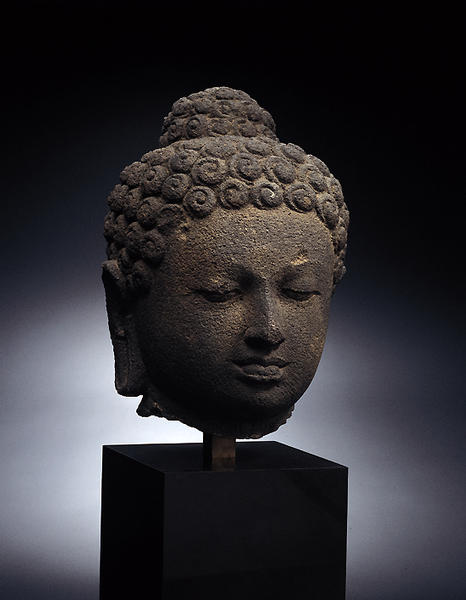Head of a Buddha
- Indonesia, Central Java
- Late 8th - early 9th century A.D.
- Andesite
- H-35 D-27 W-24
Catalogue Entry
The round outline, swelling cheeks of a head of a Buddha. The head overall, including the usnisa, forms one large globe which has been then covered on top by snail curl-shaped curls. The eyes are half-closed, the nose and mouth are relatively small, and the lower lip is fat. The expression is youthful and serene. These facial features, and the black, porous andesite all easily indicate that the work is from the Central Java region of Indonesia.
From the late 8th through early 9th century, central Java, which centers today on the city of Yogyakarta, was the site of patronage by the Shailendra royal family, and several splendid Buddhist temples and monasteries were established in the area. Carved inscriptions at these sites indicate that the Shailendra dynasty was in contact with the Pala dynasty of India, and the sculpture of this region also shows these influences. The sculpture of central Java is, however, characterized by calm expressions and symmetrically arranged bodies, and there are a number of works which show that it is more refined and ordered than that of the Pala dynasty. The Borobudur complex some 40 kilometers to the northwest of Yogyakarta is a famous example of this central Java style, and this complex built from the late 8th century to the early 9th century is known as the largest monument in the Buddhist world. Built on a square base that is 120 meters on each side, the hill-stupa is made up of five stepped layers that create a pyramidal base. Three round layers sit on the top of these five square layers. Seventy-two small stupas have been built on the round layers, and a large stupa crowns the whole. Each square layer is bound by a wall, which forms four layers of corridors. The walls on either side of these corridors are faced with 1,460 large and small panels of relief sculpture depicting Buddhist tales. In addition, there are 504 life-size seated Buddha images in the niches on top of the barrier walls of each of the square layers, and within the small stupas on the round layers. These Buddhas are shown with six different mudras, and the entire structure is thought to form a large three-dimensional mandala. This head of a Buddha is thought to have been originally the head of one of these seated Buddha images.
